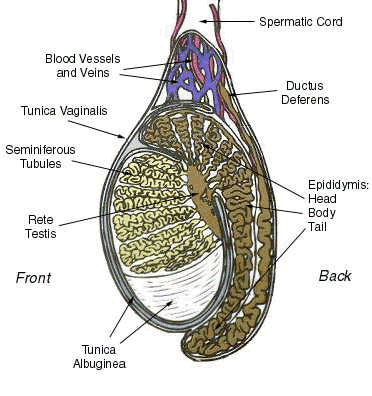
| The Testicular Cancer Resource Center |
Testicular cancer is cancer of the testicles. But while you may know where they are and you may know a little bit about what they do, chances are that you don't know what is going on inside of them. This page is intended to be a very brief overview of the anatomy and function of the testicle.

The testicles (also called testes or gonads) are the male sex glands. They are located behind the penis in a pouch of skin called the scrotum. The testicles produce sperm and testosterone. The testicles are located outside the body because sperm develop best at a temperature several degrees cooler than normal internal body temperature.
The germ cells inside the seminiferous tubules (sertoli cells) create sperm. The sperm move into the epididymis where they mature. They are stored there for a few weeks until they eventually move up the vas deferens to combine with fluids from the prostate and seminal vesicles to form what you normally think of as semen. The whole process takes about 7 weeks.
The leydig cells distributed throughout the testicle are the body's main source of testosterone. Testosterone, the male sex hormone, is essential to the development of the reproductive organs and other male characteristics such as body and facial hair, low voice, and wide shoulders. Without enough testosterone, a man will probably lose his sex drive and suffer from fatigue, depression, hot flashes and osteoporosis.
Note that when we talk about testicular cancer, we are normally talking about cancer of the germ cells. It is possible to have cancer of the leydig or sertoli cells, but these tumors are not as common and are usually not malignant. Also, since testicular cancer is associated with the germ cells, lumps or masses in the scrotum or on the epididymis, but not on the testicle, cannot be testicular cancer!
To learn more about this subject, please check out the TCRC's Urology Links page!
